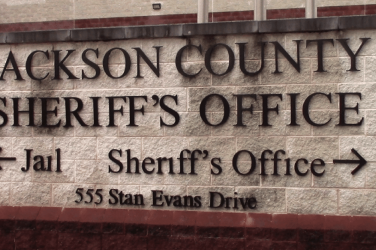This article originally appeared in Georgia Health News.
Isabelle Blaber was out horseback riding a few days before final exams in April 2016. She was 19 at the time, a freshman at Rhodes College in Memphis, and she had been a rider since she was 5.
But on this particular day she was on an unfamiliar horse, and things went wrong. In a failed attempt at a jump, she was thrown to the ground and suffered a hard blow to the back of her head.

Blaber (Photo by Devon Frasca)
Blaber remembers feeling fine immediately after the fall, and she was tempted to shrug it off. But a friend persuaded her to visit a doctor the next day, and she was fortunate she did. She had a concussion, a brain injury.
A concussion can cause headaches and, more seriously, can interfere with memory, concentration and balance.
Yet like many concussion patients, Blaber learned that her options for treatment were somewhat limited. She had to slow down her life a bit to see what happened next. “I met with the athletic trainer every day for symptom monitoring,” she says. And the doctor told her to take a break from riding.
“It was really frustrating being told what not to do,” she recalls.
The lack of therapeutic intervention has been a longstanding frustration for those who study concussions and other traumatic brain injuries. Now some Georgia researchers may be making headway in addressing the issue.
In a study published in July in the journal Nature, scientists who focus on cell regeneration at the University of Georgia reported successfully replicating some conditions of traumatic brain injuries in a Petri dish — without using an actual human brain — allowing researchers new insight into the condition.
“We thought of taking this out of the human being, because that’s where complexity confounds things,” explained the study’s lead author, Lohitash Karumbaiah, an assistant professor at the Regenerative Bioscience Center in Athens.
Simulating brain injuries in a Petri dish allowed the team to examine how different types of electrical stimulation can control, regulate and even repair the brain neurons that malfunction after a head injury. And they could do it safely, without causing further risk to any brain injury patient.

Karumbaiah
It will take some time before the application of these electrical stimulations can be re-created in real patients, but the early findings are intriguing to some, including local neurosurgeon Dr. Harlan Bruner. He was not involved in the UGA research, but has been treating severe brain injuries for a decade.
“The standard treatment is very similar in terms of care to what it was 15 to 17 years ago,” notes Bruner, who says that fact is a source of frustration for clinicians and patients alike.
If a simple technology could improve how signals to the brain’s neurons are regulated, “this certainly could have interesting impacts on future therapeutics,” Bruner says of the UGA study.
Potential Help for Millions
Brain injuries can range from the relatively mild, like the one Blaber experienced, to the severe, like the kind of injuries sustained in a major car accident. The severe ones can cause lifelong disabilities or death.
About 2.5 million people sustained traumatic brain injuries in 2010, according to the CDC. But in a 2015 report to Congress, the Atlanta-based agency said the estimates may be low, as they do not account for people who don’t see a doctor and those treated at certain military facilities and outpatient centers, among others.
 Without any treatment, brain injuries may heal very slowly, and may never heal completely. For the people with these injuries, that means their symptoms can worsen, leading to depression. And the person may be unaware of their increased risk of future concussions.
Without any treatment, brain injuries may heal very slowly, and may never heal completely. For the people with these injuries, that means their symptoms can worsen, leading to depression. And the person may be unaware of their increased risk of future concussions.
Researchers at UGA say replicating traumatic brain injuries in a Petri dish can provide much better insight into assessing the range of potential treatments.
In their three-week study, the researchers used embryonic stem cells from mice to analyze brain cells and their networks. They used glutamate — a chemical messenger that facilitates communication between nerve cells — to simulate the changes in the neurons caused by a brain injury.
The researchers found that use of high or low levels of electrical stimulation, along with controlled doses of glutamate, helped nerves to both repair and grow.
Parkinson’s disease patients have already benefited from similar electrical stimulation models, as deep brain electrode implants can help alleviate tremors. While there is reason for optimism, Karumbaiah and others caution that there remain many challenges with reproducing that type of electrical stimulations that can help injured brains.

Karumbaiah in the Regenerative Bioscience Center. (Photo by Emily Webb and Prajakta Dhapte)
For one thing, while the right amount of current could jump-start the process of regenerating the damaged nerve cells, it’s still unknown what the right amount of current would be.
“It’s still a ‘Wild West,’ as far as stimulation paradigms go,” Karumbaiah said. “We’re hoping that we can do this in a more mechanistically informed, more vigorously analyzed manner,” he added.
And Bruner, the neurosurgeon, wonders whether it would be necessary to open the skull and gain access to the brain in order to apply the electrical stimulation. With any brain surgery, there is a risk of complications, such as bleeding, infection, pain and neurological impairment.
That means more scientific investigation is needed.
“I think there is some real potential here. I will be excited to see the direction of future research,” says Bruner, while noting that “we’re talking baby steps.”
“It’s not like we’re going to cure everybody’s problems tomorrow,” he says.
In the meantime, patients continue to manage symptoms using the limited treatment methods that are currently available.

(Photo Courtesy of Isabelle Blaber)
“I was recommended to reduce stimuli: No bright lights, no loud noises and nothing mentally strenuous,” says Blaber, who experienced nausea, fatigue, balance problems, confusion and slurred speech for about two months after her 2016 fall.
Her symptoms eventually went away. But after she got another concussion in a second horseback-riding incident, her neurologist recommended that she give up the sport altogether.
She has not taken that advice, at least not completely. For a riding enthusiast like Blaber, staying out of the saddle isn’t easy. But she says she’s being careful.
“I’m not jumping and don’t ride competitively anymore . . . just for pleasure,” she says. “I mostly stick with horses I know, or horses that are ‘chill’ and easygoing.”
Alex Boss holds a bachelor of science in biology from Rhodes College in Memphis, Tennessee. She has worked as a scribe at Northside Hospital in Atlanta, an intern at Medscape and a graduate assistant for the Grady Sports Media Program. She is interested in the intersection of medicine and technology, and her current focus is on patient data privacy in the health care industry.
Prajakta Dhapte holds a bachelor of science in biotechnology from Bharati Vidyapeeth University and a master’s degree in virology from the National Institute of Virology in Pune, India. Her main interest is in communicating hard science to the general public, with a special focus in infectious disease and public health. She is also a former intern of The Indian Express, an Express Group newspaper.
Emily Webb holds a bachelor’s degree in English from LaGrange College in Georgia and is currently pursuing her master of arts in journalism. She has a special interest in lifestyle, religion, health care and food and nutrition. She enjoys writing, reading and traveling. Her current project focuses on exploring the relationship between faith-based health care institutions and access to care.







